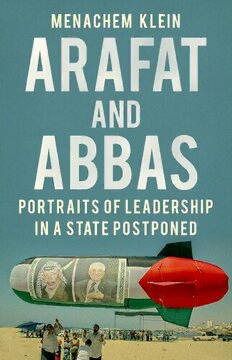
Arafat and Abbas: Portraits of Leadership in a State Postponed PDF
Preview Arafat and Abbas: Portraits of Leadership in a State Postponed
ARAFAT AND ABBAS MENACHEM KLEIN Arafat and Abbas Portraits of Leadership in a State Postponed 3 3 Oxford University Press is a department of the University of Oxford. It furthers the University’s objective of excellence in research, scholarship, and education by publishing worldwide. Oxford is a registered trade mark of Oxford University Press in the UK and in certain other countries. Published in the United States of America by Oxford University Press 198 Madison Avenue, New York, NY 10016, United States of America © Menachem Klein, 2019 First published in the United Kingdom in 2019 by C. Hurst & Co. (Publishers) Ltd All rights reserved. No part of Publication may be reproduced, stored in a retrieval system, or transmitted, in any form or by any means, without the prior permission in writing of Oxford University Press, or as expressly permitted by law, by license, or under terms agreed with the appropriate reproduction rights organization. Inquiries concerning reproduction outside the scope of the above should be sent to the Rights Department, Oxford University Press, at the address above. You must not circulate this work in any other form and you must impose this same condition on any acquirer A copy of this book’s Cataloging-in-Publication Data is on fi le with the Library of Congress. ISBN 9780190087586 CONTENTS Prologue vi 1. Arafat, the Icon as President, and His Antihero Successor 1 2. Foreign Policy: Abbas, the Deserted Peace Seeker 35 3. In-House Order: Weak Authoritarian Presidents 93 4. Succession Struggle 151 Appendix 1: Main Points of Difference Between Olmert Proposal September 2008 and Abbas Positions 175 Appendix 2: The Settlements Project—An Overview 179 Acknowledgements 181 Notes 183 Bibliography 213 Index 219 v PROLOGUE On a hot August day in 1993, I was in my Jerusalem home, unpacking my luggage after a fellowship year at St. Antony’s College, Oxford, when the phone rang. On the other end of the line was the Voice of Israel correspondent for Palestinian affairs. He wanted to interview me on the breaking news: Israel and the PLO had agreed on mutual recognition through the Oslo Accords. As a junior researcher at the Hebrew University, I had followed Palestinian affairs since 1990. However, my main field of study was Egypt’s society and culture, on which I submitted my PhD in 1992. When I heard the news, I sharply switched my academic focus. I was later to become involved in formal and unofficial Israeli–Palestinian peace talks. The portraits of Arafat and Abbas this book offers, based on twenty-five years of follow- ing their lives closely, are the outcome of that phone call. Like many others in the region and beyond, in 1993 I consid- ered the Oslo agreement to be the precursor to a forthcoming peace treaty. It turned out to be much less, merely an interim agreement on establishing Palestinian autonomy, postponing for seven years the decision on its final status. I did not know that both Rabin and Peres opposed any solution that involved an independent Palestine.1 Indeed, the road ahead looked open in those optimistic years. The Oslo Accords arrived in the era of the vii PROLOGUE fall of the Berlin Wall, the liberation of Eastern Europe, the expansion of the European Union and globalisation. Twenty-five years later, it is clear that I was wrong to assume that the Oslo process was unstoppable or irreversible. Israeli–Palestinian peace, bringing this interim stage to an end, does not seem to be on the horizon. An ethnocentric–religious government rules Israel, and the Palestinian Authority is far from democratic. International media reports regularly on Israeli–Palestinian clashes, between stories on natural disasters. The young twenty-first century resembles the first decades of the twentieth century, rather than its end. Populist and authoritarian regimes have been elected in central Europe, American President Donald Trump is isolating the US from its western European allies and the European Union faces cracks in its foundations, not least with Brexit. The glory of the twentieth century’s anti-colonial struggles is over. Along with the playing upon fear of jihadist terror, populists have warned that immigration from the Middle East and Africa will lead to western Europe societies losing their national iden- tity and social cohesion. Wracked by civil wars and unrest, the Middle East seems in a hopeless situation. However, as this book suggests, a close examination of Palestinian social dynamics shows that beneath the present state of affairs, the potential for change lurks. An occupation that today seems permanent could be pushed away tomorrow by a nation determined to achieve liberation and self-determination. This book is a portrait of two political leaders, each at the head of a twenty-five year old political entity. The components of each portrait do not fit together perfectly, nor depict a photo- realistic view of the subject. In addition, as with any portrait, the depictions of Arafat and Abbas include my interpretation of the facts of history. The first chapter describes the two personalities and their roads to power. The second concerns their foreign policy, in particular the relations with Israel and the US. In the viii
